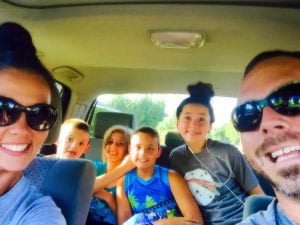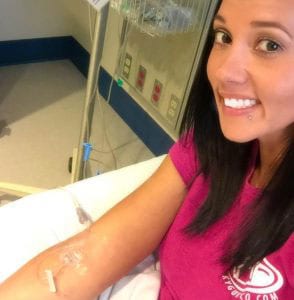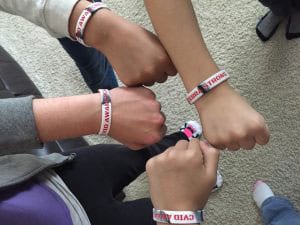We want to celebrate our patient contributors and writers for their efforts in helping the rare community, bringing awareness, understanding and compassion to often neglected disease. The following article was originally published in early 2016 but we know that with every new diagnosis, this story can help a family, patient or caregiver in need of camaraderie and support. As we jump into 2017 we’re #LookingBack on some of the most poignant stories of previous years. Take a look at this story about CVID.
Candace gathered her cards, launched “Oceans” in the background, and pressed play as she began to record a video explanation of her rare, frequently misunderstood disease, Common Variable Immune Deficiency (CVID).
What she probably didn’t plan for is the video’s growth in views, resulting in increased awareness of CVID and providing other patients with a relatable, shareable, explanation of the CVID experience.
Candace says that her video attempts to explain the condition and CVID symptoms, in reality “[the video] barely scratches the surface on what CVID does to individuals, but it’s a start.”
She was inspired to make the video for her friends, family and strangers who ask what CVID is, stating that it can be incredibly hard to explain.
She says, “People often assume when you’re immunocompromised that it’s HIV or AIDS but it’s so different. I hope sharing the video helps educate somebody or help somebody tell someone about CVID.”
Some of her close friends and family have done their own research but Candace knows that CVID can be difficult to understand, especially because, “No two zebras have the same stripes. No two individuals have the same symptoms.”
She says, “People with CVID struggle their whole life until they’re diagnosed. Some are diagnosed as infants and some like me don’t get diagnosed until 33 years later. You get the name of a hypochondriac.”
Candace has had over 30 surgeries and she’s only 34.

She lives in small, southern, rural town and many doctors in the area don’t know what CVID is. She says “Going so many years without a diagnosis you’re either thought of as a hypochondriac or your doctors get frustrated with you because you keep going back saying that a medicine isn’t working.”
The path to Candace’s diagnosis began with swollen lymph nodes in her neck and behind her ears. Her primary care physician sent her to an ear, nose, and throat doctor who did a biopsy. It came back abnormal and at first they thought she might have cancer. “They couldn’t figure out what it was, I was terrified for a long time. I got sent to an infectious disease doctor. He tested me for everything you can think of, I had so much blood taken out of me. They told me you don’t have an infectious diseases, I’m not the doctor you need to see, I’ve found some alarming things in your blood work. I think you need to see a friend of mine who’s an immunologist. He threw out that he thought I might have CVID.”
A couple months later that tentative diagnosis was confirmed.
Candace was recommended to do the treatments life-long. She had never heard of CVID, knew nothing about what it was or how it differed from AIDS.
She was scared. “I did a lot of research, I prayed for understanding.”
She was very nervous for her first treatment. The fact that the treatment was a blood product from so many people made her a little worried about the possibility of contracting hepatitis or HIV, “It was kind of scary, I didn’t know what to expect but I’d read about the side effects.” Candace has only been diagnosed for about a year.
“It’s hard to let it sink in, I’m still struggling with that. I feel better that now it has a name, I don’t have to wonder what is wrong with me. That’s a relief but there are days where it’s still hard to understand that I have something that doesn’t have a cure and causes so many different symptoms. There’s so many things that come with it. But it is what it is, I can make the best of it.”
This is not to say that it’s not hard sometimes, as Candace says it can be “Very difficult and stressful. It makes it really hard to be a mother when your child is sick with the flu. I have to be very careful. I can’t hold them because if I get it, it could be very bad for me, it could be fateful. I have to protect myself and that’s a terrible feeling. Kids are the biggest germ factory, so are schools and doctors’ offices. We have a routine where everyone uses germx and an understanding that at the first sniffle you tell mom. If you’re feeling yucky, put up precautions. I have an amazing family. My mom, my husband… I cannot tell you how great they are for me, they go the extra mile to help me. And my kids, ages 15-6 too. Even my youngest knows, ‘ I have to help mom.’
She said the treatments helped noticeably at first but because the treatment is really just supplying your body with what it doesn’t have and it doesn’t last, the biggest impact has been simply that she hasn’t gotten as sick as she has in the past.

Candace recommends the IDF and finding CVID support and awareness pages, stating that she gets a lot of encouragement from those. Support and understanding is always welcome but particularly when you have something you may have to explain to your physicians.
“When you’re new to this diagnosis at first you do feel alone because you haven’t heard of it or anybody who has it until you find support group pages and then a whole other world is opened up to you and you see you’re not alone. They know what you’re going through; they truly understand.”
“You are your strongest advocate, you really are.”
She says that “you kind of get shut down sometimes”, recalling an experience with her family physician who was dismissive even after he was sent information regarding CVID. “Other doctors feel intimidated I guess, when it’s something they don’t know about.” She mused.
She had a negative experience with a dentist as well. “CVID scared her a little. She thought I’d contaminate the office supplies… I can laugh about it now but when you’re going through it, it makes you feel like you’re diseased and contaminated. I think it has a lot to do with living in a small town, CVID is just unheard of; it’s kind of frightening.”
Luckily, she has had positive experiences as well.
She says that her regular dentist was very understanding and did her own research, and ultimately decided to prescribe more antibiotics to Candace than she would for other patients, recognizing that Candace can’t fight off bacteria like they can. “She was amazing just because she took the extra time to figure out what’s going on with me so that she could treat me better.”
Candace is thrilled with the number of views her video is getting, saying, “That video, I never expected it to get much attention from it, I think God laid it on my heart to spread the word about CVID. I never ever expected it to go so far. It makes me so happy to read comments saying ‘I’m so glad you made this video, my family understand now.’ It makes me feel so good that my video helped somebody else say something. There’s a real human being behind this disease. It’s just been an amazing experience for me. Even with my kids, I have four and my oldest is 15, she understands best, people ask ‘What’s wrong with your mom, why is she wearing a mask? Why is she sick all the time’, the video helps.”

She hopes that patients will advocate for themselves, spread the word, and educate people. She tells as many people as she can about CVID and hopes that more awareness will result in more funding for research. She says that she herself learns more and more every day; finding support groups and educational groups.
Her advice to someone who was just diagnosed?
“Just breathe. It’s all going to be ok. You’re going to go through ups and downs and experience lots of different symptoms. Some of it can be a little scary but you’re not alone, there are people out there, including myself, who will help you. Don’t be afraid to ask questions because if you don’t ask, you don’t know. And don’t give up hope.”
Join Candace in making CVID awareness go viral by sharing this article to your social networks!
All images were provided by Candace






